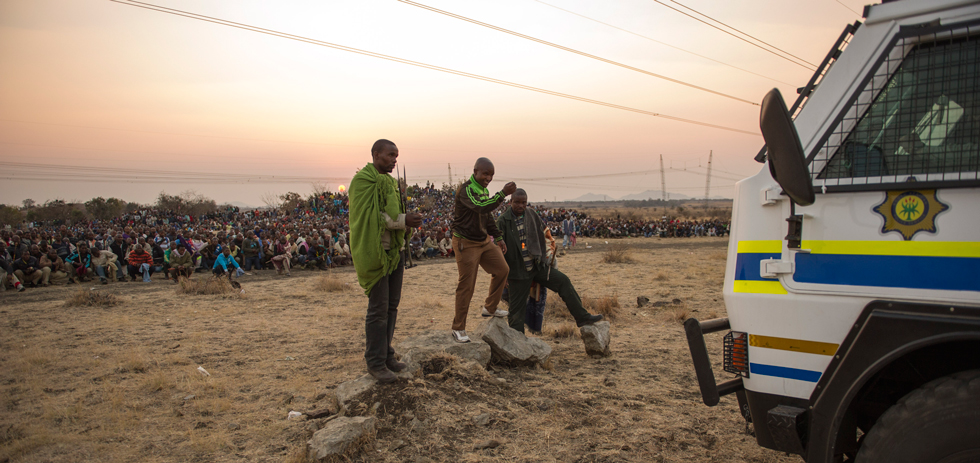
Rehad Desai’s Miners Shot Down isn’t a particularly well-crafted documentary, with an overreliance on talking head interviews and Desai’s didactic voiceover to try and direct the viewer to see the Marikana massacre as a microcosm of the abuse of workers rights across the country. Whilst that issue is important, this approach sees Desai caught between the roles of investigative journalist and documentarian, when his strength clearly lies with the former. What lifts Miners Shot Down considerably, then, is Desai’s access to and usage of some incredibly damning footage; the true power of the film is derived from a well documented shifting first-person account of collusion and confusion, as the police acted in the interests of a mining company and quashed a workers’ strike, killing 34 people following a week of protesting.
In August 2012, workers in the platinum mines of Marikana, owned by British mining company Lonmin, went on strike to seek a tripling of their wages, after it became apparent that the major union of the miners, the National Union of Miners (NUM), was in the pocket of the ruling government party (the RNC, still in power) and were refusing to negotiate with Lonmin on the miners’ behalf. On the 10th of August they walked off the job and towards the Lonmin head office, where company spokesmen refused to negotiate with any party bar the miners’ unions. In the days that followed South African police were called in to monitor the protests, their roles morphing into something akin to Lonmin’s own security force, culminating in the massacre of over 30 miners on the 16th of August. Desai himself is no stranger to politically charged events, his father was a prominent anti-apartheid campaigner and he himself was in exile from South Africa until 1990.1 As such, Miners Shot Down exists as a filmic piece of activism, a fiery indictment of corruption in government, police and unions, moreso than traditional documentary.
The film starts clumsily, leading with snapshots of the horrors of the massacre then jumping straight into the days leading up to the event, the suddenness of framing makes it seem like the film is unsure whether its target audience is international or local. Desai seems to want to provide some understanding of unions and labour workings in South Africa yet often only addresses it on a surface level. His overarching attack on corruption is likewise a touch reductive, placing a lot of focus on a tale of perceived personal corruption – that of former union leader and anti-apartheid campaigner Cyril Ramaphosa, now the Deputy President of South Africa, and who appears in the film as a Lonmin shareholder. By so heavily leaning on the notion that this one event is indicative of corruption and abuse generally, the events leading up to the massacre are presented to us as talking points moreso than compelling investigation.
That noted, once the film moves towards its middle it improves drastically. Where at the start the film Desai seems unsure of whether to provide a lecture or a window into an investigation, the access to police and security footage is a fairly remarkable and gripping device when used to analyse the minutiae of the protests leading up to the massacre. It’s also good to see Desai rely on the power of the footage itself, more so than his explanatory voiceover, as it is this bare imagery that truly resonantes. The amount of footage shown, in addition to some clever editing from the mammoth editing team (Kerryn Assaizky, Menno Boerema, Megan Gill, Steen Johannessen, and Reuben van der Hammen), manages to achieve both an investment in this singular horrific event whilst also managing to subtlety touch on issues of entrenched corruption, as well as the aforementioned horror of the intersection of police power and confusion of orders.
An interesting idea explored primarily, though not explicitly, in the talking heads interviews is the continuation of colonisation through capitalism. Throughout the strike, the British owned-Lonmin showcase willful ignorance of the light of their workers, one spokesman claimed that no company could have anticipated the violent protesting and that they would seek out a police crimes unit to fine “the root cause” of their workers’ violent impulses. The rise of these mining companies clearly appears as a means through which a class system can be reinforced, Lonmin’s workers are low-paid, uneducated and ostensibly in poverty, yet the connection between Lonmin and the police (and the RNC) protects the financial elite. One worker, in one of the most stirring lines in the film, says “your boss will be the son of your father’s boss”, when discussing how their job reinforces a division of classes.
What Miners Shot Down might lack in nuance and didactic insight, it manages to capture your attention as a result of an understanding of the power of evidence (an entire segment of the film focuses on the post-massacre inquiry) and shocking video footage.
